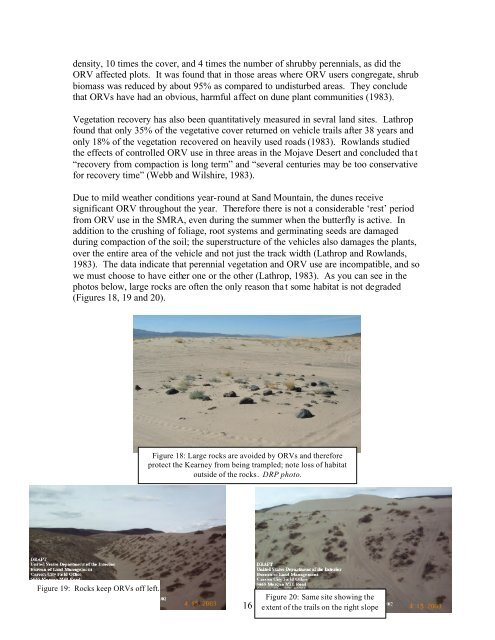Sand Mountain blue butterfly - The Xerces Society
Sand Mountain blue butterfly - The Xerces Society
Sand Mountain blue butterfly - The Xerces Society
Create successful ePaper yourself
Turn your PDF publications into a flip-book with our unique Google optimized e-Paper software.
density, 10 times the cover, and 4 times the number of shrubby perennials, as did the<br />
ORV affected plots. It was found that in those areas where ORV users congregate, shrub<br />
biomass was reduced by about 95% as compared to undisturbed areas. <strong>The</strong>y conclude<br />
that ORVs have had an obvious, harmful affect on dune plant communities (1983).<br />
Vegetation recovery has also been quantitatively measured in sevral land sites. Lathrop<br />
found that only 35% of the vegetative cover returned on vehicle trails after 38 years and<br />
only 18% of the vegetation recovered on heavily used roads (1983). Rowlands studied<br />
the effects of controlled ORV use in three areas in the Mojave Desert and concluded that<br />
“recovery from compaction is long term” and “several centuries may be too conservative<br />
for recovery time” (Webb and Wilshire, 1983).<br />
Due to mild weather conditions year-round at <strong>Sand</strong> <strong>Mountain</strong>, the dunes receive<br />
significant ORV throughout the year. <strong>The</strong>refore there is not a considerable ‘rest’ period<br />
from ORV use in the SMRA, even during the summer when the <strong>butterfly</strong> is active. In<br />
addition to the crushing of foliage, root systems and germinating seeds are damaged<br />
during compaction of the soil; the superstructure of the vehicles also damages the plants,<br />
over the entire area of the vehicle and not just the track width (Lathrop and Rowlands,<br />
1983). <strong>The</strong> data indicate that perennial vegetation and ORV use are incompatible, and so<br />
we must choose to have either one or the other (Lathrop, 1983). As you can see in the<br />
photos below, large rocks are often the only reason that some habitat is not degraded<br />
(Figures 18, 19 and 20).<br />
Figure 18: Large rocks are avoided by ORVs and therefore<br />
protect the Kearney from being trampled; note loss of habitat<br />
outside of the rocks. DRP photo.<br />
Figure 19: Rocks keep ORVs off left.<br />
16<br />
Figure 20: Same site showing the<br />
extent of the trails on the right slope
















